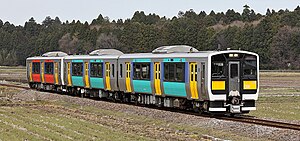KiHa E130 series
| KiHa E130 series | |
|---|---|
 3-car KiHa E130 series formation on the Suigun Line, April 2010 | |
| In service | 2007–Present |
| Manufacturer | Niigata Transys, Tokyu Car Corporation |
| Replaced | KiHa 110 series |
| Constructed | 2006– |
| Number built | 49 vehicles |
| Number in service | 49 vehicles |
| Formation | 1 or 2 cars per unit |
| Operators | JR East |
| Depots | Suigun (Hitachi Daigo) |
| Lines served | Suigun Line, Kururi Line |
| Specifications | |
| Car body construction | Stainless steel |
| Car length | 19,500 mm (64 ft 0 in) |
| Width | 2,920 mm (9 ft 7 in) |
| Floor height | 1,130 mm (3 ft 8 in) |
| Doors | Three pairs per side |
| Maximum speed | 100 km/h (60 mph)* |
| Prime mover(s) | DMF15HZ x1 per car |
| Power output | 331 kW (444 hp) per car |
| Transmission | Hydraulic |
| Bogies | DT74 (motored), TR259 (trailer) |
| Safety system(s) | ATS-Ps |
| Multiple working | KiHa 110 series |
| Track gauge | 1,067 mm (3 ft 6 in) |
The KiHa E130 series (キハE130系) is a diesel multiple unit (DMU) train type operated by East Japan Railway Company (JR East) in Japan since January 2007.[1][2]
Fleet
- KiHa E130-0: 13 single-car units used on the Suigun Line since January 2007
- KiHa E131 + KiHa E132: 13 two-car units used on the Suigun Line since January 2007
- KiHa E130-100: 10 single-car units for use on the Kururi Line since 1 December 2012
Suigun Line
The Suigun Line fleet, based at Suigun Depot (Hitachi Daigo), consists of 39 cars formed as 13 single-car KiHa E130 units and 13 2-car (KiHa E131 + KiHa E132) sets. These trains are operated on services between Ibaraki and Fukushima. They entered service from January 2007, totally replacing the KiHa 110 series DMUs previously used on this line by September of the same year.[3]
Kururi Line
Ten new KiHa E130 series cars were introduced on the Kururi Line in Chiba Prefecture from 1 December 2012, replacing the ageing KiHa 30, KiHa 37, and KiHa 38 DMU cars previously operated.[4]
The Kururi Line KiHa E130-100 series sets have DT74A motored bogies and TR259A trailer bogies.[5]
-
Kururi Line KiHa E130-104 at Kisarazu Station, October 2012
Exterior
The single-car (KiHa E130) units have red colouring on the sides, while the two-car (KiHa E131 + KiHa E132) units have turquoise colouring. The doors and cab end panels of both types are yellow.
Interior
Passenger accommodation consists of 1+2 abreast facing seating bays in the centre of each car, and longitudinal bench seating at the ends of cars. Toilets (in KiHa E130 and KiHa E131 cars) are universal access.[3]
The Kururi Line KiHa E130-100 series cars have longitudinal seating only, and are not fitted with toilets.[4]
The cars are equipped with fare machines for use on wanman driver-only-operated services.[3]
-
Wheelchair-accessible toilet, April 2010
-
Interior of a Kururi Line KiHa E130-100 series car, January 2013
-
LCD passenger information display inside a Kururi Line KiHa E130-100 series car, January 2013
Formations
KiHa E130-0 single-car units
- KiHa E130-1–13
| Numbering | KiHa E130 |
|---|---|
| Weight (t) | 38.7 |
| Capacity Total/seated |
113/34 |
(Equipped with a toilet)
KiHa E130-0 2-car units
- KiHa E131-1–13 + KiHa E132-1–13
| Numbering | KiHa E131 | KiHa E132 |
|---|---|---|
| Weight (t) | 36.7 | 35.9 |
| Capacity Total/seated |
125/40 | 131/48 |
(KiHa E131 is equipped with a toilet.)
-
Single-car KiHa E130-11 at Mito Station, August 2010
-
KiHa E131-2 at Mito Station, September 2007
-
KiHa E132-2 at Mito Station, September 2007
History
The first KiHa E130 single-car units were delivered from Niigata Transys in December 2006, with 12 cars delivered by the end of January 2007. KiHa E130-13 was delivered in August 2007. Deliveries of the two-car sets began in February 2007, with the final sets delivered in August 2007. All of the two-car sets were built by Niigata Transys except for two sets, 8 and 9, which were built by Tokyu Car Corporation.[3]
The first three KiHa E130-100 series cars (101 to 103) destined for use on Kururi Line services were delivered from Niigata Transys in August 2012,[6] followed by the remaining seven cars (104 to 110) in October 2012.[7] These are scheduled to enter revenue service from 1 December 2012.[4]
References
- ^ "平成19年1月、水郡線にデビュー キハE130系気動車". Japan Railfan Magazine. Vol. 47, no. 551. Japan: Kōyūsha Co., Ltd. March 2007. pp. 62–63.
{{cite magazine}}: Unknown parameter|trans_title=ignored (|trans-title=suggested) (help) - ^ "水郡線へ集中投入された新型車両 キハE130系一般形気動車". Japan Railfan Magazine. Vol. 47, no. 552. Japan: Kōyūsha Co., Ltd. April 2007. pp. 84–89.
{{cite magazine}}: Unknown parameter|trans_title=ignored (|trans-title=suggested) (help) - ^ a b c d Nishiwaki, Kōji (January 2012). "JR各社の新世代気動車の現状 JR東日本キハE120・E130・E131・E132形". Japan Railfan Magazine. Vol. 52, no. 609. Japan: Kōyūsha Co., Ltd. pp. 98–101.
{{cite magazine}}: Unknown parameter|trans_title=ignored (|trans-title=suggested) (help) - ^ a b c "JR東日本 久留里線にキハE130形を導入". Tetsudō Daiya Jōhō Magazine. Vol. 41, no. 343. Japan: Kōtsū Shimbun. November 2012. pp. 70–71.
{{cite magazine}}: Unknown parameter|trans_title=ignored (|trans-title=suggested) (help) - ^ "キハE130形100番台". Japan Railfan Magazine. Vol. 52, no. 620. Japan: Kōyūsha Co., Ltd. 2012. pp. 62–63.
{{cite magazine}}: Unknown parameter|trans_title=ignored (|trans-title=suggested) (help) - ^ "8/29, キハE130-100, 木更津に到着". Japan Railfan Magazine. Vol. 52, no. 619. Japan: Kōyūsha Co., Ltd. November 2012. p. 170.
{{cite magazine}}: Unknown parameter|trans_title=ignored (|trans-title=suggested) (help) - ^ "キハE130系100番台が甲種輸送される". Japan Railfan Magazine Online (in Japanese). Japan: Koyusha Co., Ltd. 20 October 2012. Retrieved 20 October 2012.
{{cite web}}: Unknown parameter|trans_title=ignored (|trans-title=suggested) (help)
External links
- KiHa E130 series information Template:Ja icon
- JR East KiHa E130 series (Japan Railfan Magazine) Template:Ja icon







